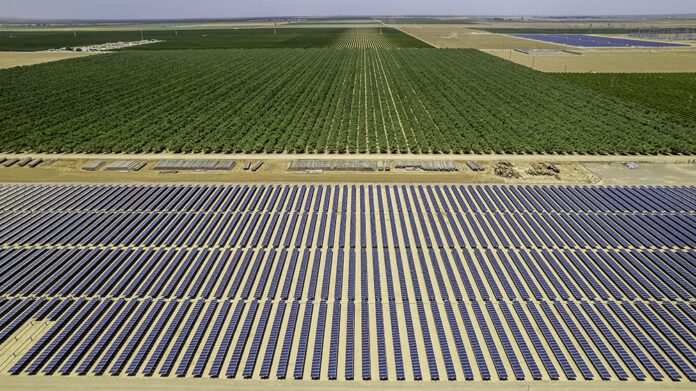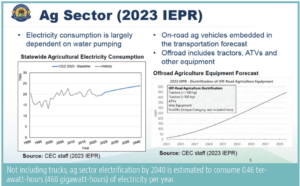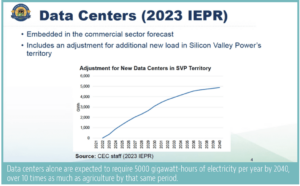
Do you remember the 2010 movie Unstoppable with Denzel Washington and Chris Pine, where a runaway train loaded with toxic materials was heading full speed into the city? The same drama is playing out right now in California as the state is uncontrollably racing toward disaster in the effort to completely electrify the state.
In previous articles, we have discussed California’s ambitious goals to address climate change by eliminating combustion and mandating everything go electric, including cars, trucks, forklifts, furnaces and buildings all in the next 20 or so years. It has been our impression this would tax the already undersized electric infrastructure system in the state. As we have mentioned, to build or expand tree nut facilities in the San Joaquin Valley, we are utilizing natural gas generators and solar installations. We truly believed the conversion to electric would cripple this state, but we had no idea what else might be out there that would make this situation even worse.
In an ongoing effort to understand the electric infrastructure situation, the California Energy Commission (CEC), in conjunction with the California Public Utilities Commission (CPUC), is preparing the Integrated Energy Policy Report (IEPR). According to the CEC, the IEPR Report is a collaboration of stakeholders designed to assess the state’s energy needs as it shifts away from oil and natural gas to renewable energy resources and alternative transportation vehicles. The report will provide policy recommendations with regards to the state’s future energy demands and needs. As part of this process, a special hearing was conducted this past May to identify electric load growth areas throughout California over the next 10 to 25 years. It was an eye-opener.
Out of the gate, the state began with information on what they expect the ag sector and industrial sector to need in terms of electricity consumption. In the ag sector, they estimated agriculture will be consuming 0.46 terawatt-hours (TWh) or 460 gigawatt-hours (GWh) of electricity per year by 2040. That does not include trucks; it only includes tractors, ATVs, forklifts and other equipment. Meanwhile, the CEC is expecting the industrial sector to consume more than 46 TWh by 2040. To seemingly confirm that incredibly high number, Southern California Edison estimated industrial electricity consumption to be at 4.4 TWh in 2045 in their territory alone. On a side note, SCE reported machine drives and refrigeration will make up the bulk of that electricity demand.
That alone is scary, but it doesn’t begin to describe the demand that is coming. Next up to present at the IEPR hear was Microsoft, which made a presentation on “data centers”. Data centers are buildings designed just for storing electronic data. Imagine thousands of hard drives and thousands of fans to cool the hard drives. These buildings range from 50 kW to 1,000 megawatts. The CEC estimated that data centers alone will demand almost 5 TWh or 5,000 GWh of electricity demand by 2040. PG&E seemed to confirm that by reporting they see data center growth at an annual 10% rate over the next five years and a global demand of 8,000 TWh by 2030.


But this still isn’t the only significant demand headed our way. One energy alternative that appears to be gaining steam is hydrogen. Many believe hydrogen will truly be the favored energy source when it comes to heavy-duty trucking as there is no weight penalty (i.e., batteries) and has the same power or better than diesel to get those loaded trucks up and over the Grapevine or Altamont passes. However, how do you create hydrogen? The most common way to create hydrogen is through electrolysis, which applies electricity to water to split the hydrogen and oxygen atoms apart and produce hydrogen. How much electricity you might wonder? SCE estimates that electrolysis in their territory alone will need 18,200 GWh by 2045. UC Irvine reported at the meeting they expect hydrolysis will go from zero today to needing 350 TWh or 350,000 GWh by 2050.
So, let’s add this up. Agriculture will consume 0.46 TWh, industrial will use 46 TWh, data centers need 5 TWh and hydrolysis 350 TWh. That means we will need more than 451 terawatt hours of electricity production by 2040. If you assume that much consumption was spread out over the whole year, we will need 0.45 terawatts of instantaneous demand. That is equivalent to 450 gigawatts or 450,000 megawatts. To put that into perspective, the nuclear power plant at Diablo Canyon only produces 2,250 megawatts at peak capacity. In other words, we need 200 Diablo Canyon power plants to produce the power needed just for ag, industrial, data centers and hydrolysis. That doesn’t speak to houses, businesses or transportation.
Where are we today? In 2022, California consumed a total of 287,220 GWh. This is a little more than one half of what we need by 2040, meaning we need to double our electricity production from what it is today. And we know California will only allow wind and solar to be the sources. Current wind only produces almost 32,000 GWh and solar about 49,000 GWh. So solar and wind currently only provide less than 30% of our total electricity consumption.
This only addresses the huge supply shortfall. What about the fact that the substations, poles, and lines are at maximum capacity throughout the state? What about the fact that PG&E claims they need a new substation for every 20 MW of new demand? This state is in no way ready to handle the coming electricity load. Remember last year when the Governor pushed his Climate Change agenda and then begged everyone not to charge their cars because the system was short during peak hours. Remember when they were going to shut down Diablo Canyon but then extended its contract through 2030? Well, state officials met last month to proceed with decommissioning plans. So, they want to shut down the one stable continuous energy source, when we need 199 more Diablo Canyon plants?
In the words of the immortal Johnny Cash, “I hear the train a-comin’, it’s rolling ’round the bend…”

Roger A. Isom | President/CEO, Western Agricultural Processors Association
Roger is President/CEO of the California Cotton Ginners and Growers Association and Western Tree Nut Association. He brings over 30 years of regulatory and legislative advocacy experience, specializing in environmental and safety matters. Roger’s responsibilities include the management of both Associations’ staff and day-to-day operations. Roger is also the President of the Ag Energy Consumers Association (AECA), board member and Past President of the Ag One Foundation at California State University Fresno, and manages the Navel Orangeworm Action Committee (NOWAC).















